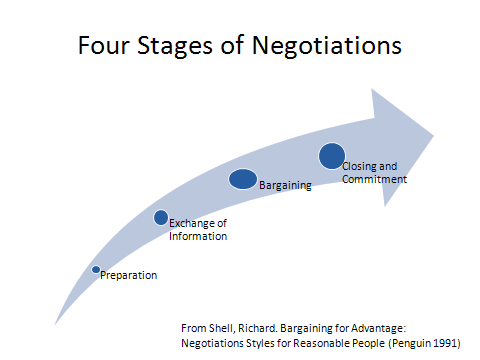
The negotiator’s playbook includes a handful of tactics and a few dirty tricks.
Real estate, construction, and remodeling fall into the category of transaction-oriented businesses, where a succession of single sales remains the focus, rather than building a client base. While referrals and happy customers become the bedrock of any successful enterprise, there is a sharp difference in the sales goals of a homebuilder and that of an insurance agent. Homebuilders don’t develop a steady book of business. They develop land and close deal after deal, year after year, with little repeat business. For this reason, most builders become unwitting experts in the subtle, although sometimes brutal, art of negotiation.
Few of us ever study negotiation from a theoretical perspective, although you can obtain a Ph.D. in negotiation at Harvard. Many diplomats negotiating international treaties have one. Builders typically hone their skills on the job site, negotiating with clients, subcontractors, material suppliers, and employees. They focus on getting what’s needed, and not on refining the methods used to achieve it.
Some naturally gifted negotiators become successful on the basis of a salesman’s sixth sense, while others struggle and suffer with this sometimes-frustrating aspect of doing business. It helps to know a bit about how the professionals approach high-stakes negotiations, so that constructing a deal becomes as satisfying as building a deck.
How to overcome uncertainty
Most of us begin our career in sales by telling potential customers what we can do for them, how well, how soon, and how reasonably priced. If a potential customer has already made the decision to buy a house or to remodel, then this approach works fine. In today’s climate of economic uncertainty, however, customers may feel hesitant to commit. They may be looking, but may not have made the decision to buy.
Here the first step in making a deal comes with understanding the customers’ situation, needs, and concerns so that you can help them make the commitment to a purchase–from anyone. The second step is to show them how well your services align with their best interest. This process is not just a sale, like buying gum at the convenience store; it’s a negotiation.
Every negotiation begins with an exchange of information. Your tool kit includes questions and active listening. A customer calls and asks something along the lines of, “How much per square foot for an addition?” You can react with irritation, or you can start asking questions. “How big is your house now?” “How will you use the addition?” “How long have you been thinking about adding on?” With this line of inquiry, you’re doing two things: gathering information you will use to show this customer exactly how your services respond to their specific desires, and creating an investment on their part in your relationship. After feeding you lots information, they pay attention to your response.
When you respond, remember that you’re appealing to the customer’s self-interest. If you learned they want to remodel because the value of their house does not allow them to sell and buy something larger, point out that the average selling price still exceeds the cost of remodeling, so that they will actually enjoy greater equity with the added square footage. Given people will do more to avoid a loss than score gains, point out that modernizing the house will preserve its value into the future. That is, if they want to sell, explain how wonderful their new house at the old location will make them feel!
You have not yet sold them on what you will do, or for how much. To determine that, you need to know even more information, and you need a set of blueprints and specifications. Too many of us help customers develop this refined vision “on the house” with the hope of a future job Get them to put skin in the game. You’ve already spent an hour on the phone mostly listening. Instead of making suggestions at this point, say, “if I understood you correctly, you …,” and then recap precisely and concisely what you know about their needs, wants, and limitations. Explain that you can help them achieve this, probably for less money (although you never answer their first question, “How much?”) and would like to team up with them to develop a strategy.
This is where you invite them to refine their vision through a preliminary design and budget proposal. You ask them to invest a small amount, maybe $500, for this service. Set an appointment to discuss it. Having hired you as a consultant, they’ll be primed to move quickly into contract negotiations. Yes, you will waste the occasional hour building a relationship that leads nowhere, but you will weed out nonstarters and avoid devoting days to dead-end bidding.
When it’s time to submit a proposal, submit three. Many consumers believe in the three-bid process, but since their ideas are not sufficiently developed, they compare apples to oranges and mandarins. You can shortcut this by providing your customer with three options to consider, each with a price and list of benefits and compromises. All of these techniques keep the conversation going and keep you at the center of consideration.
So what are the dirty tricks? Negotiators can take two approaches: win-win and win-lose. You’ll encounter win-win more often; it’s the most creative approach and what you hope to achieve every time. But if you sell homes or bid jobs competitively, you’ll occasionally get a taste of the most vicious sorts of negotiations. These can become stomach-churning nightmares, or if you play them in the spirit of smash-mouth football (I’m a Husker fan), you can actually enjoy the ruthless competition. Win-lose negotiators use the elements of withholding critical information, misleading, and surprise. Even if you’re not the type, knowing win-lose strategies will keep you from becoming the dupe.
In our next installments of the Self-Taught MBA, we will delve deep into the negotiator’s tool kit, creative win-win strategies, and the most devious gambits of distributive bargaining, such as the Decoy, the Red Herring, and the Deliberate Mistake.
Fine Homebuilding Recommended Products
Fine Homebuilding receives a commission for items purchased through links on this site, including Amazon Associates and other affiliate advertising programs.

Reliable Crimp Connectors

Handy Heat Gun

Affordable IR Camera




























